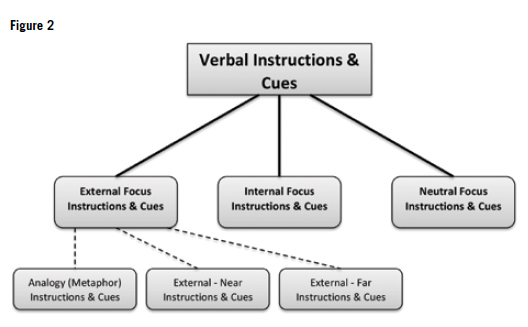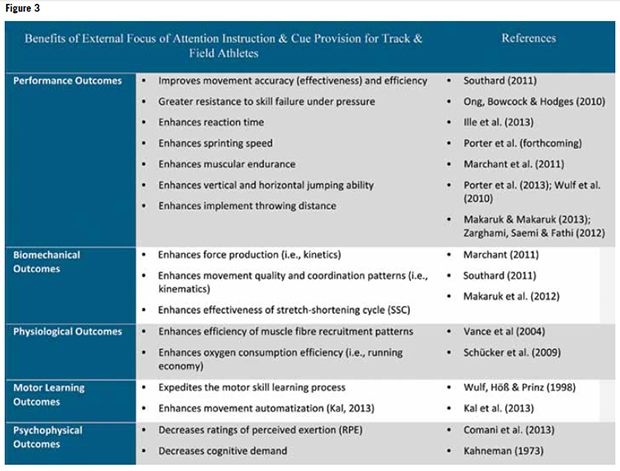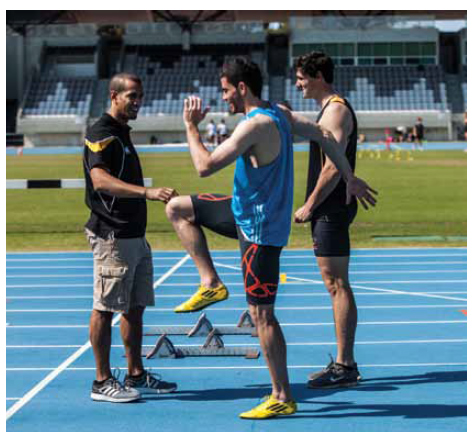| By: Adam Benz, MKin, CSCS
Originally Published in: Techniques Magazine - USTFCCCA
Verbal cues are short goal-directed, task-oriented phrases, generally one or two words in length, verbally administered to an individual prior to or during a motor skill performance to direct the performer's attention to task relevant stimuli in order to enhance athletic performance and, or motor skill learning. External focus cues are goal-directed, task-oriented verbal cues that directs conscious attention towards performing an action without specifically mentioning any body parts. Analogy (metaphor) cues are short phrases, generally 1-2 words in length, that utilize a biomechanical metaphor in order to reduce the amount of information consciously processed during movement. External-near cues are short, 1-2 word phrases that instruct the individual to focus on outcome or performance results or environmental features closer to the individual. External-far cues are short, 1-2 word phrases that instruct the individual to focus on outcome or performance results or environmental features farther from the individual. Internal focus cues are goal-directed, task-oriented verbal cues that direct conscious attention towards performing an action with specifically mentioning body parts involved in the movement. Neutral focus cues are verbal cues that direct a person's conscious attention to non-awareness by not promoting a specific attention allocating strategy.
In a case study using one of the most successful coaches (in terms of championships) in the history of the National Collegiate Athletic Association (NCAA), the legendary University of California, Los Angeles (UCLA) basketball coach John Wooden, who coached his team to seven consecutive NCAA men's basketball titles from 1967-1973, was observed and recorded during afternoon practices throughout the 19741975 basketball season (Tharp & Gallimore, 1976). It was determined that 50 percent of what Wooden verbally communicated to the athletes during practice was instructions (what to do, how to do it) and rarely provided instructions lasting over 20 seconds (Gallimore & Tharp, 2004). This study supports the conclusion that a large percentage of what a successful coach communicates to an athlete during training is brief verbal instructions, and thus how one provides those instructions then becomes of high importance as it can affect how the athlete performs motor skills. When the coach provides verbal instructions or cues to an athlete, the athlete can then process that information and determine how to focus their atten-tion on the subsequent performance as a result of the instruction or cue provided by the coach. This process can either help or hurt the athlete's performance depending on how they decide to focus their attention. The literature indisput-ably supports that focusing externally can enhance sport performance (Wulf, 2013), while focusing internally can be detrimental to sport performance (Porter, Ostrowski & Wulf, 2010; Schiicker et al., 2009). In this regard, coaches can enhance athlete performance by altering the wording of their instructions and cues. However, coaches should be careful with using internal focus instructions or cues, as the majority of sport science and motor learning research has shown that they can have a detrimental effect on athletic performance when compared to external focus and control conditions (i.e., neutral focus group) in some cases. HOW DOES VERBAL INSTRUCTIONS AND CUES INFLUENCE ATHLETE PERFORMANCE? Within the spectrum of external focus instructions and cues, external-far (also known as distal external focus of attention) instructions have been shown to elicit significantly better motor learning (McNevin, Shea & Wulf 2003) and performance outcomes (Porter et al., 2013) compared to external-near, internal and control conditions. Multiple motor learning and sport science researchers have stated that external far instructions may potentially enhance movement auto-maticity of the athlete by providing the individual an easily discernible difference between the body and the movement goal, thus potentially being the reason for the augmentation of the external far effects on athletic performance (Craig, 2013; Wulf, 2013). The sport skills within track and field that have been shown to benefit from external or neutral focus of attention instructions and, or cues include running (Schiicker et al., 2009), sprinting (Ille et al., 2013; Mallett & Hanrahan, 1997; Porter & Sims, 2013; Porter et al., Forthcoming; Sims, 2010), horizontal jumping (Porter et al., 2010; Porter et al., 2013), vertical jumping (Makaruk et al., 2012; Wulf et al., 2010), discus throwing (Zarghami et al., 2012) and shot putting (Makaruk, Porter & Makaruk, 2013). One such case where providing neutral focus of attention instructions and, or cues may benefit sport performance is for expert sprinters. As Porter & Sims (2013) found that expert sprinters performed significantly better in the neutral focus condition than either the internal or external focus conditions for a 9.14 minute split. In regards to the beneficial effects of external focus instructions and cues on track and field sport performance, it is likely that the improved performance outcomes for running, sprinting, throwing and jumping are a result of improvements in biomechanical, physiological, psycho-physical and motor learning outcomes observed when the athlete focuses externally. For coaches desiring to enhance the sport performance of athletes, one simple and beneficial way this can be done is to provide external focus of attention instructions and cues to athletes during practice and competition.
REFERENCES An, J.; Wulf, G.; Kim, S. (2013). Increased carry distance and X-factor stretch in golf through an external focus of attention. Journal of Motor Learning and Development, 1, 2-11. Ashraf R.; Aghdasi, MT.; Sayyah, M.; Taghibiglo, N. (2012). The effects of inter-nal and external focus of attention on chil-dren's performance in vertical jump task. International Journal of Basic Sciences & Applied Research, 1(1), 1-5. Bell, J.; Hardy, J. (2009). Effects of atten-tional focus on skilled performance in golf. Journal of Applied Sport Psychology, 21(2), 163-177. Chiviacowsky, S.; Wulf G.; Avila, L.T.G. (2012). An external focus of atten-tion enhances motor learning in children with intellectual disabilities Journal of Intellectual Disability Research, 1-8. doi: 10.1111111365-2788.2012.01569.x Chiviacowsky, S.; Wulf G.; Wally, R. (2010). An external focus of attention enhances balance learning in older adults. Gait & Posture, 32(4), 572-575. Comani, S.; Di Fronso, S.; Filho, E.; Castronovo, A.M.; Schmid, M.; Bortoli, L.; Conforto, S.; Robazza, C.; Bertollo, M. (2013). Attentional focus and functional connectivity in cycling: An EEG case study. Paper presented at the XIII Mediterranean Conference on Medical and Biological Engineering and Computing, Seville, Spain. Craig, L.C. (2013). The effects of focused attention on batting performance of collegiate athletes. (Master of Arts in Psychology), University of Central Oklahoma, Edmond, Oklahoma. Fasoli, S.E.; Trombly, C.A.; Tickle-Degnen, L.; Verfhellie, M.H. (2002). Effect of instructions on functional reach in persons with and without cerebrovascular accident. American Journal of Occupational Therapy, 56(4), 380-390. Gallimore, R.; Tharp, R. (2004). What a coach can teach a teacher, 19752004: reflections and reanalysis of John Wooden's teaching practices. The Sport Psychologist, 18(2), 119-137. Ille, A.; Selin, I.; Do, MC.; Thon, B. (2013). Attentional focus effects on sprint start performance as a function of skill level. Journal of Sports Sciences, 31(15), 1705-1712. Kahneman, D. (1973). Attention and effort. Englewood Cliffs, New Jersey. United States of America: Prentice Hall. Kal, E.C.; van der Kamp, J.; Houdijk, H. (2013). External attentional focus enhanc-es movement automatization: A com-prehensive test of the constrained action hypothesis. Human Movement Science, 32(4), 527-539. Laufer, Y; Rotem-Lehrer, N.; Zohar, R.; Khayutin, G.; Rozenberg, I. (2007). Effect of attention focus on acquisition and reten-tion of postural control following ankle sprain. Archives of Physical Medicine and Rehabilitation, 88(1), 105 - 108. Makaruk, H.; Porter, J.; Czaplicki, A.; Sadowski, J.; Sacewicz, T. (2012). The role of attentional focus in plyometric training. The Journal of Sports Medicine and Physical Fitness, 52(3), 319-327. Makaruk, H.; Porter, J.; Makaruk, B. (2013). Acute effects of attentional focus on shot put performance in elite athletes. Kinesiology, 45(1), 55-62. Mallett, C.J.; Hanrahan, S.J. (1997). Race modeling: An effective cognitive strategy for the 100 m sprinter? The Sport Psychologist, 11, 72-85. Marchant, D.; Greig, M; Bullough, J.; Hitchen, D. (2011). Instructions to adopt an external focus enhance muscular endurance. Research Quarterly for Exercise and Sport, 82(3), 466-473. Marchant, D.C. (2011). Attentional focusing instructions and force production. Frontiers in Psychology, 1(210), 1-9. McNevin, N.H.; Shea, C.H.; Wulf G. (2003). Increasing the distance of an external focus of attention enhanes learning. Psychological Research, 67(1), 22-29. Ong, N.; Bowcock, A.; Hodges, N. (2010). Manipulations to the timing and type of instructions to examine motor skills performance under pressure. Frontiers in Psychology, 1, 1-13. Peh, S.Y; Chow, J. Y; Davids, K (2011). Focus of attention and its impact on movement behaviour. Journal of Science and Medicine in Sport, 14(1), 70-78. Porter, J.M., Ostrowski, E., Nolan, R., & Wu, W. (2010). Standing long-jump performance is enhanced when using an external focus of attention. Journal of Strength and Conditioning Research, 24(7), 1746-1750. Porter, J.M.; Anton, P.M.; Wikoff N.; Ostrowski, J. (2013). Instructing skilled athletes to focus their attention externally at greater distances enhances jumping performance. Journal of Strength and Conditioning Research, 27(8), 2073-2078. Porter, J.M.; Nolan, R.; Ostrowski, E.; Wulf G. (2010). Directing attention externally enhances agility performance: a qualitative and quantitative analysis of the efficacy of using verbal instructions to focus attention. Frontiers in Psychology, 1(216). doi: 10.3389/fpsyg.2010.00216 Porter, J.M.; Sims, B. (2013). Altering focus of attention influences elite athletes sprinting performance. International Journal of Coaching Science, 8(2), 22-27. Porter, J.M.; Wu, W.F.; Partridge, J.A. (2010). Focus of attention and verbal instructions: strategies of elite track and field coaches and athletes. Sport Science Review, 19(3), 77-89. Porter, J.M.; Wu, W.F.; Crossley, R.M.; Knopp, S.W.; Campell, 0. (Forthcoming). Adopting an external focus of attention improves sprinting performance. Manuscript submitted for publication. Schacker, L.; Hagemann, N.; Strauss, B.; Volker, K (2009). The effect of attentional focus on running economy. Journal of Sports Sciences, 27(12), 1241-1248. Sims, B.A. (2010). Focus of attention influences elite athletes sprinting performance. Southern Illinois University Carbondale, Carbondale: OpenSIUC. Southard, D. (2011). Attentional focus and control parameter: effect on throwing pattern and performance. Research Quarterly for Exercise and Sport, 82(4), 652-666. Tharp, R.G., & Gallimore, R. (1976). Basketball's John Wooden: What a coach can teach a teacher. Psychology Today, 9(8), 74-78. Vance, J.; Wulf, G.; Tanner, T.; McNevin, N.; Mercer, J. (2004). EMG activity as a function of the performers' focus of attention. Journal of Motor Behavior, 36(4), 450-459. Wulf G. (2013). Attentional focus and motor learning: a review of 15 years. International Review of Sport and Exercise Psychology, 6(1), 77-104. Wulf G.; Dufek, J.; Lozano, L.; Pettigrew, C. (2010). Increased jump height and reduced EMG activity with an external focus of attention. Human Movement Science, 29(3), 440-448. Wulf G.; Hag M; Prinz, W. (1998). Instructions for motor learning: differential effects of internal versus external focus of attention. Journal of Motor Behavior, 30(2), 169-179. Wulf G.; McConnel, N.; Gartner, M.; Schwarz, A. (2002). Enhancing the learning of sport skills through external-focus feedback. Journal of Motor Behavior, 34(2), 171-182. Wulf G.; Zachly, T.; Granados, C.; Dufek, J. S. (2007). Increases in jump-and-reach height through an external focus of attention. International Journal of Sports Science & Coaching, 2(3), 275-284. Zachly, T.; Wulf G.; Mercer, J.; Bezodis, N. (2005). Increased movement accuracy and reduced EMG activity as the result of adopting an external focus of attention. Brain Research Bulletin, 67(4), 304-309. Zarghami, M; Saemi, E.; Fathi, I. (2012). External focus of attention enhances discus throw-ing performance. Kinesiology, 44(1), 47-51. 0
Adam Benz is an accredited Level 2 sprints coach for Athletics Australia. Current sports science Ph.D. candidate within the Faculty of Computing, Health & Science at Edith Cowan University (ECU) in Perth, Western Australia, specializing in coaching, motor learning and sprint performance.
|
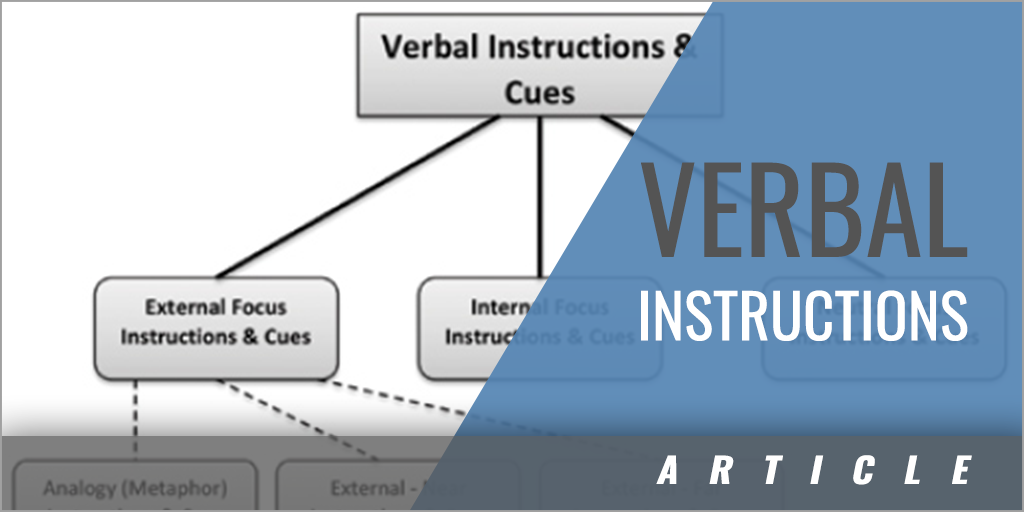



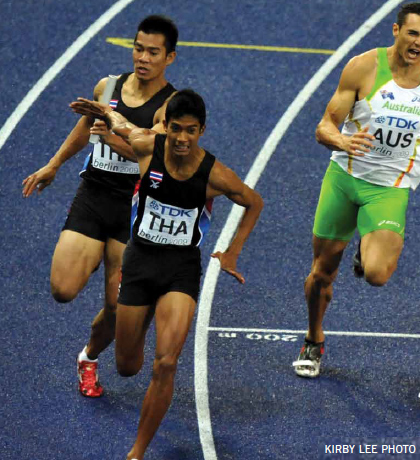 WHAT ARE VERBAL INSTRUCTIONS AND CUES?
WHAT ARE VERBAL INSTRUCTIONS AND CUES?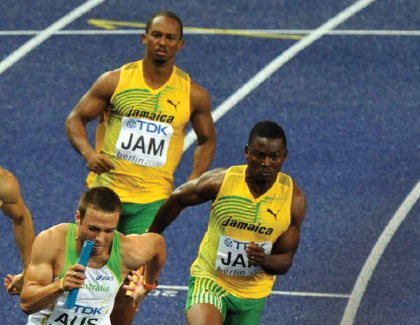
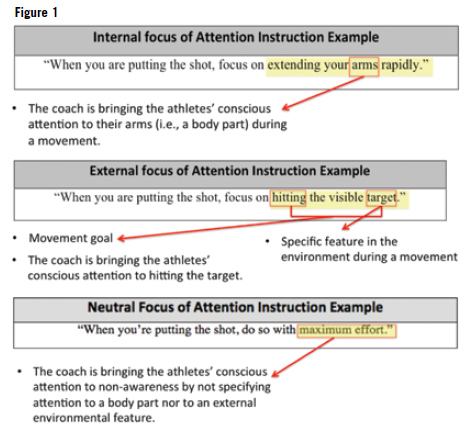 WHY IS PROVIDING VERBAL INSTRUCTIONS AND CUES IMPORTANT FOR COACHING AND ATHLETE PERFORMANCE?
WHY IS PROVIDING VERBAL INSTRUCTIONS AND CUES IMPORTANT FOR COACHING AND ATHLETE PERFORMANCE?